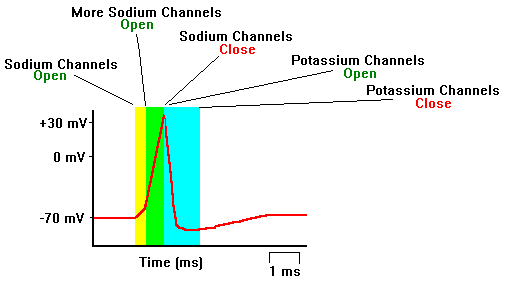

This paper is intended to analyse all-or-none principle in Hodgkin-Huxley mathematical model. The paper combined mathematical and computational modelling to prove a weakness in a very precious model in neuroscience. Therefore, in a field as rapidly developing as neuroscience, the combination of these two modellings can have a significant role in helping to guide the direction the field takes. Stronger stimuli bring more muscle fibres into action and thus the tension of a muscle increases as the strength of the stimulus applied to it rises.Mathematical and computational modellings are the necessary tools for reviewing, analysing, and predicting processes and events in the wide spectrum range of scientific fields. The contraction is not increased if the stimulus strength is further raised. However, it responds maximally when the stimulus rises to threshold. In the case of muscle fibres, the individual muscle fibre does not respond at all if the stimulus is too weak.

The force of the contraction obtained depends on the state in which the muscles fibres find themselves.
All or none principle full#
Accordingly, the auricles or ventricles behave as a single unit, so that an adequate stimulus normally produces a full contraction of either the auricles or ventricles. If the external stimulus is too weak, no response is obtained if the stimulus is adequate, the heart responds to the best of its ability. Heart muscle is excitable, i.e., it responds to external stimuli by contracting. Increasing the stimulus further does increase the response of whole nerve. The minimal effective (i.e., threshold) stimulus is adequate only for fibres of high excitability, but a stronger stimulus excites all the nerve fibres. If a nerve trunk is stimulated, then as the exciting stimulus is progressively increased above a threshold, a larger number of fibres respond. The above account deals with the response of a single nerve fibre. This demonstrates the all-or-none relationship in spike production. Stimuli too weak to produce a spike do, however, set up a local electrotonus, the magnitude of the electronic potential progressively increasing with the strength of the stimulus, until a spike is generated.

This relationship holds only for the unit of tissue for nervous tissue the unit is the nerve cell, for skeletal muscle the unit is the individual muscle fiber and for the heart the unit is the entire auricles or the entire ventricles. This property of the single nerve fibre is termed the all-or-none relationship. Either the single fibre does not respond with spike production, or it responds to the utmost of its ability under the conditions at the moment. If it is of threshold strength or over, a spike (a nervous impulse) of maximum magnitude is set up. An electrical stimulus below threshold strength fails to elicit a propagated spike potential. The magnitude of the action potential set up in any single nerve fibre is independent of the strength of the exciting stimulus, provided the latter is adequate. Larger stimulus does not result in a larger response, vice versa. Īs long as the stimulus reaches the threshold, the full response would be given. The individual fibres of nerves also respond to stimulation according to the all-or-none principle. This principle was later found to be present in skeletal muscle by Keith Lucas in 1909. It was first established by the American physiologist Henry Pickering Bowditch in 1871 for the contraction of heart muscle.Īn induction shock produces a contraction or fails to do so according to its strength if it does so at all, it produces the greatest contraction that can be produced by any strength of stimulus in the condition of the muscle at the time. The nerve fibre either gives a maximal response or none at all. If the intensity or duration of the stimulus is increased, the height of the impulse will remain the same. In physiology, the all-or-none law (sometimes the all-or-none principle or all-or-nothing law) is the principle that if a single nerve fibre is stimulated, it will always give a maximal response and produce an electrical impulse of a single amplitude.

Short description: Physiological principle


 0 kommentar(er)
0 kommentar(er)
